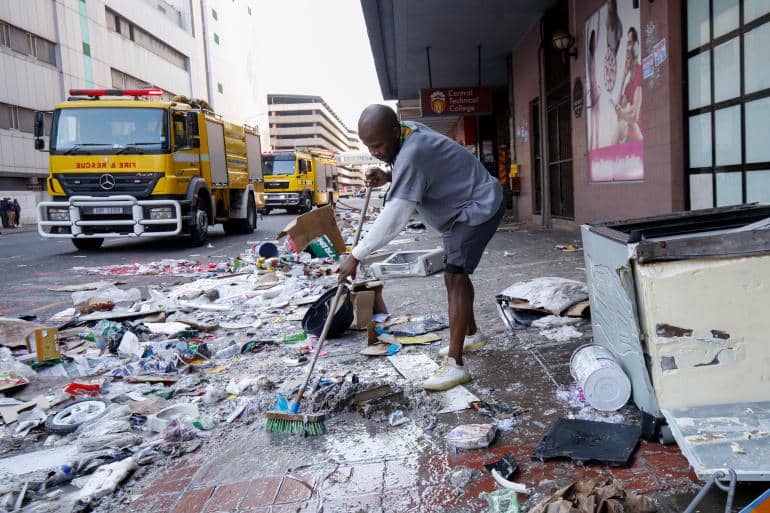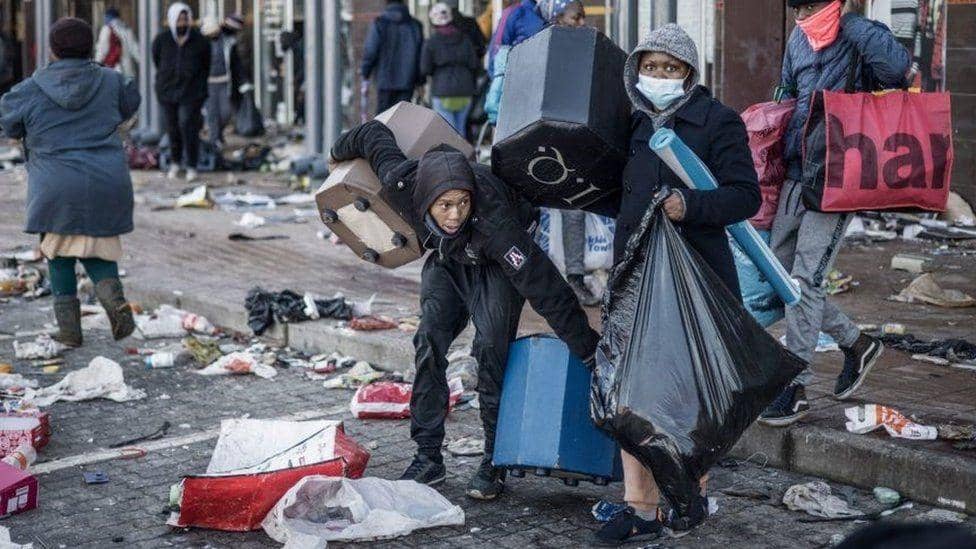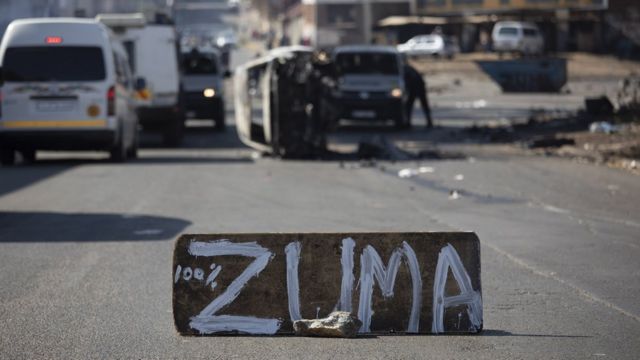South Africa is battling its worst riots since the end of the Apartheid in 1994. Instability, unrest and violence are currently dominating political discourse in South Africa and the severity of this situation has evoked concern from all across the globe. With over 200 dead, arson, large scale looting, explosions, rioting, food insecurity and complete pandemonium; it is imperative to analyse what exactly sparked this state of chaos in a country that not long ago was among the top 5 countries in Africa, and is now being deemed as a “failed state” by some.
The immediate trigger for the upheaval was the imprisonment of former President Jacob Zuma, who was sentenced to fifteen months for contempt of court. Jacob Zuma served as the President from 2009 to 2018, when he resigned over years of corruption allegations. Under Zuma’s administration, that was infamous for its cronyism and corrupt practices, South Africa’s rank fell from 55 to 73 on the Transparency International’s global index that ranks corruption globally.
What’s interesting to note here is the ability of the South African judiciary to hold Zuma accountable and reinforce the fact that no South African is above the constitution, a move that gave a harsh blow to official corruption, a practice that is so widespread and deep rooted in almost every other country on the map. While this may have led to the worst violence South Africa has seen in decades, one cannot diminish the significance this development holds in a democratic country.

The protests started two days after Zuma’s arrest and gained ground in Zuma’s home province KwaZulu-Natal, which is home to 11 million of its citizens. While it remains unproven, it is believed that these protests were politically motivated by Zuma’s supporters to undermine Ramaphosa’s rule. Zuma’s daughter compared Ramaphosa’s administration to the Apartheid era leadership and used her social media to call her followers to protest against Zuma’s arrest. Using one’s established platform and influence to incite violence has become rather common in today’s times.
The U.S. capitol riots that took place earlier this year, with Trump allegedly motivating his supporters to march down to the Capitol, which also resulted in complete chaos, violence and disarray bear testament to this fact.
Prior to Zuma handing himself over to the police, his supporters showed up at his residence in solidarity, in order to prevent the authorities from taking him into custody. These protests then morphed into full-blown riots, where the protestors resorted to arson, blockading roads, looting factories and shopping centres and cascaded into unrest. Even though these protests were initiated to show solidarity and support for Zuma, they have transcended into ‘opportunistic attacks of criminality’ with people inciting chaos as a garb for loot and theft.
President Ramaphosa has addressed these protests as strategic attempts and coordinated campaigns to ‘attack and sabotage’ the democracy. Seeing the situation escalate out of proportion, Ramaphosa called for the deployment of 25,000 military troops to stabilise the areas. The riots spread to Gauteng, the country’s smallest province and havoc has had a persistent presence all throughout the country with each passing day.
A rather concerning development is the large scale looting of super markets, grocery stores and increasing cases of food trucks being destroyed by the rioters. This only intensifies the fight against food shortages. While Zuma’s arrest may have been the imminent reason for unleashing this upheaval; several ingrained, malignant problems that have plagued South Africa are responsible for setting the ground for the same. The most significant underlying problem that has contributed to this buildup is the deep-seated discontent and poverty amongst the South Africans, predominantly the black majority; that has only been exacerbated by the pandemic.
Wave after wave sent the country’s economy into a downward spiral with prospects of normalcy trotting further away. Even before the pandemic struck, the gulf between the minority White population and the majority Black population in terms of resources, income and standard of living was significant. With the pandemic came the rise in unemployment, fall in income and increasing costs; which further widened this gulf and deepened the misery of the majority Black population. According to an article in the Wall Street Journal, 43% of workers were out of their jobs by the end of March 2021. The riots were used as a medium to channelize frustration, hopelessness and angst that filled the public sentiment.

The riots further compounded the effect of the pandemic. Seeing the ghastly situation on the roads and the violence, health care workers are unable to report for duty. Already struggling to contain the emerging variants and dealing with the problem of short staffing; experts predicted that South Africa would be seriously hit by the third wave. Due to their slow vaccination drive, only 2.8% of the total population has been fully vaccinated.
To top this off with attacks and looting of pharmacies, health centres, laboratories, vaccination sites and torching of ambulances makes South Africa more vulnerable than ever. It would come as no surprise that the riots would act as a super spreader of the virus, and the number of cases would witness a sharp rise in the coming weeks. Disruption of the country’s already slow vaccination programme is a matter of grave concern.

While the rioting has reduced with the deployment of the military, the situation still remains extremely tense and needs cautious monitoring.
The South African economy contracted by 7% in 2020 alone, largely because of the Covid restrictions put in place that hampered almost all sectors of their economy, especially tourism; with a huge decline in demand. Already having one of the highest inequality rates in the world, South Africa is in a state of disarray. The World Bank reported that close to 160 million people will be in poverty by the end of 2021. While these may just be statistics and numerical figures to some, it is imperative to understand the magnitude of the problem these numbers depict. A spike in violence all over the world, be it in Columbia, Sudan or Cuba, helps us reach a crucial understanding of how the pandemic has exacerbated the already prevalent problems to a stage where mayhem and chaos seem to be the new order of conduct.
Written by- Shweta Dilawari
Edited by- Krish Sharma
